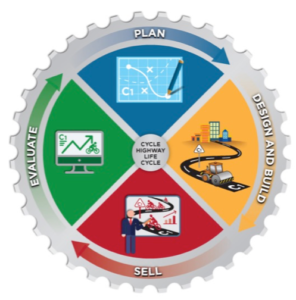Conference / Cycling / Infrastructure / Research
Cycling Further: Bicycle Highways in North West Europe
Cycling highways are a relatively new mobility product in North West Europe. Connecting areas with cycle highways intends to make cycling a viable option for longer journeys. With the rapid development of e-bikes, the idea has a lot of potential.
However, the approach to this next-level piece of infrastructure varies between countries. Perspectives on the planning process, design features and attracting cyclists to the route differ. Since 2016, the CHIPS project is working on the development of the concept of cycling highways through exchanging knowledge between regions and developing new tools to work towards a shared view.

CHIPS is short for Cycling Highways Innovation and People Transport in Spatial Planning. While at Mobycon, I spend my time conducting research, running campaigns and preparing pilots in CHIPS on behalf of the Dutch Province of Gelderland. Together with the CHIPS partners, the life cycle of the cycle highway has come into being. The Province of Gelderland focuses on the planning phase.
Through several pilots in Gelderland and collecting information from our project partners, we are working on the question: ‘are cycling highways competitors or complementary to other modes of transport?’ This leads to recommendations on integrating cycle highways into the bigger transport network in the planning phase. Next to this, Gelderland is collaborating with Radboud University to conduct research on the planning process and the stakeholders who are involved. As a result, we will present guidelines on governance strategies. All the results from this stage of the CHIPS project will be captured in a manual that explains each component of the cycling highway’s life cycle.
Are you interested in the development of cycling highways in North Western Europe? In May next year, we will present our results at the final CHIPS conference and then later at the Cycle Highway Academy in Frankfurt. But if you can’t make it to Frankfurt, you can contact me with questions about how CHIPS is making the bike go further!


 ">
">